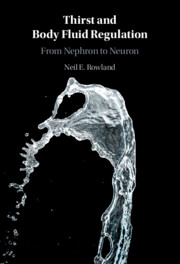Book contents
- Thirst and Body Fluid Regulation
- Thirst and Body Fluid Regulation
- Copyright page
- Contents
- Figures
- Preface
- 1 Fundamentals of Thirst and Body Fluid Regulation
- 2 Body Fluid Compartments, Inputs, and Outputs
- 3 Intracellular Dehydration Thirst and Drinking
- 4 Intracellular Dehydration: Mechanism
- 5 Extracellular Dehydration Thirst and Drinking
- 6 Pregnancy and the Ontogeny of Thirst
- 7 Food-Associated Drinking and Nycthemeral Rhythms
- 8 Hybrid Dehydrations: Water Deprivation
- 9 Hybrid Dehydrations: Thermal Stress and Exercise
- 10 Thirst in Aging and Clinical Populations
- 11 Comparative Aspects of Body Fluid Regulation
- Appendix Methods in Physiology and Neuroscience
- References
- Index
4 - Intracellular Dehydration: Mechanism
Published online by Cambridge University Press: 09 December 2021
- Thirst and Body Fluid Regulation
- Thirst and Body Fluid Regulation
- Copyright page
- Contents
- Figures
- Preface
- 1 Fundamentals of Thirst and Body Fluid Regulation
- 2 Body Fluid Compartments, Inputs, and Outputs
- 3 Intracellular Dehydration Thirst and Drinking
- 4 Intracellular Dehydration: Mechanism
- 5 Extracellular Dehydration Thirst and Drinking
- 6 Pregnancy and the Ontogeny of Thirst
- 7 Food-Associated Drinking and Nycthemeral Rhythms
- 8 Hybrid Dehydrations: Water Deprivation
- 9 Hybrid Dehydrations: Thermal Stress and Exercise
- 10 Thirst in Aging and Clinical Populations
- 11 Comparative Aspects of Body Fluid Regulation
- Appendix Methods in Physiology and Neuroscience
- References
- Index
Summary
Cellular dehydration caused by stimuli such as hypertonic NaCl or mannitol cause a sustained shrinkage of osmosensitive cells, and in osmosensitive neurons this is transduced into a proportional change in firing rate. The basal firing rate of these neurons may encode an effective set point for osmoregulation. In the brain, these osmoreceptors seem to be predominantly in the SFO, MnPO, and OVLT. From selective lesion and other evidence, it appears that these regions act in a synergistic manner, such that optimal drinking and/or AVP secretion occurs when all three of these interconnected regions are functional. Some data suggest that there may be species differences in the details of this integrated functioning of the lamina terminalis.
- Type
- Chapter
- Information
- Thirst and Body Fluid RegulationFrom Nephron to Neuron, pp. 50 - 72Publisher: Cambridge University PressPrint publication year: 2021

